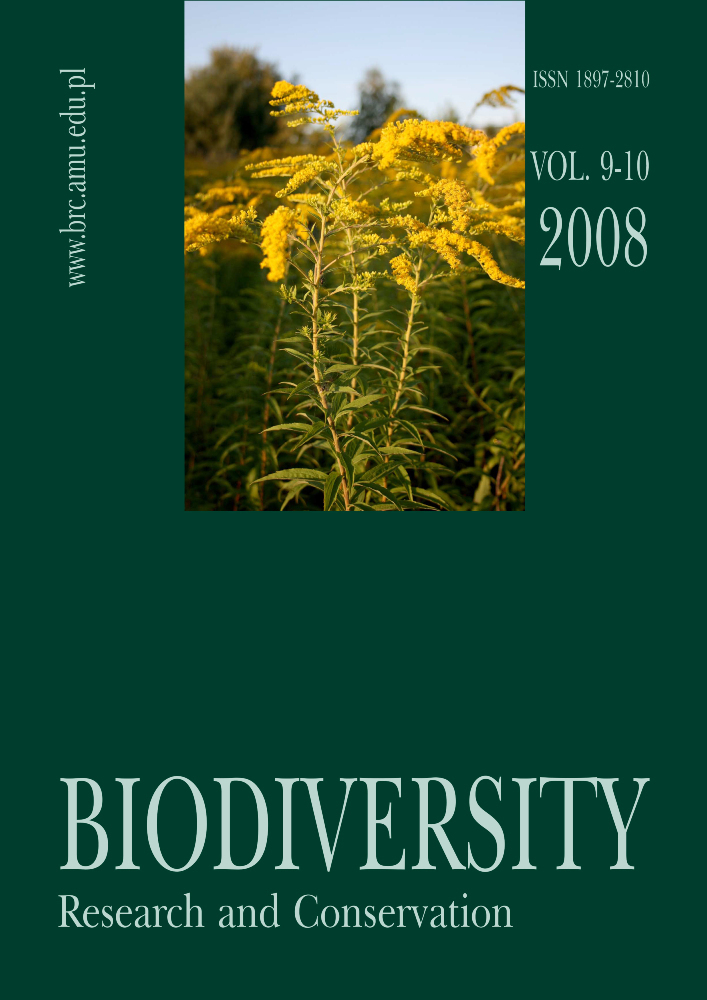Abstract
In this paper, data on penetration of anthropophytes into alluvial phytocoenoses, collected in the years 2006-2007, were analysed with reference to the level of their disturbance, community structure and localization of patches. The investigation was carried out in the whole Skawica valley (in the area comprising villages Zawoja, Skawica and Białka). On the basis of 106 phytosociological relevés, eight associations were distinguished: Rorippo-Agrostietum, Phalarido-Petasitetum hybridi, Filipendulo ulmariae-Menthetum longifoliae, Phalaridetum arundinaceae, Glycerietum plicatae, Thyphetum latifoliae, Alnetum incanae, Salicetum albo-fragilis. It was stated that phytocoenoses undisturbed or less disturbed are penetrated with anthropophytes in smaller degree while riparian forest associations are more threated by anthropophytes. Invasive species – Impatiens glandulifera, Impatiens parviflora and Reynoutria japonica – most frequently penetrate phytocoenoses of Alnetum incanae, Salicetum albo-fragilis, Phalarido-Petasitetum hybridi and Filipendulo ulmariae-Menthetum longifoliae. Communities which are free from penetration by anthropophytes in this area include rush associations: Glycerietum plicatae and Typhetum latifoliae.
References
DAJDOK Z. & ANIOŁ-KWIATKOWSKA J. 1998. Wstępne wyniki badań nad ekspansją niecierpka gruczołowatego (Impatiens glandulifera Royle) w dolinie Odry. Bad. Fizjogr. Pol. Zach. seria B-Botanika 47: 195-204.
DAJDOK Z., ANIOŁ-KWIATKOWSKA J. & KĄCKI Z. 1998. Impatiens glandulifera Royle in the floodplain vegetation of the Odra River (West Poland). In: U. STARFINGER, K. EDWARDS, I. KOWARIK & M. WILLIAMSON (eds.). Plant Invasions: Ecological Mechanisms and Human Responses, Leiden, The Netherlands: Backhuys, pp. 161-168.
DAJDOK Z. & KĄCKI Z. 2003. Kenophytes of the Odra riversides. In: A. ZAJĄC, M. ZAJĄC & B. ZEMANEK (eds.). Phytogeographical problems of synantropic plants, pp. 131-136. Institute of Botany, Jagiellonian University, Cracow.
DRESCHER A. & PROTS B. 2003. Distribution patterns of Himalayan Balsam (Impatiens glandulifera Royle) in Austria. In: A. ZAJĄC, M. ZAJĄC & B. ZEMANEK (eds.). Phytogeographical problems of synanthropic plants, pp. 137-146. Institute of Botany, Jagiellonian University, Cracow.
FALIŃSKI J. B. 1969. Neofity i neofityzm. Dyskusje fitosocjologiczne (5). Ekol. Pol. ser. B. 15(4): 337-354.
HEJDA M. & PYŠEK P. 2006. What is the impact of Impatiens glandulifera on species diversity of invaded riparian vegetation? Biological Conservation 132(2): 143-152. DOI: https://doi.org/10.1016/j.biocon.2006.03.025
GNIAZDOWSKA A. 2005. Oddziaływania allelopatyczne – „nowa broń” roślin inwazyjnych. Kosmos. Problemy Nauk Biologicznych 54(2-3): 221-226.
KASPEREK G. 2004. Fluctuations in numbers of neophytes, especially Impatiens glandulifera, in permanent plots in a west German floodplain during 13 years. Neobiota 3: 27-37.
MATUSZKIEWICZ W. 2005. Przewodnik do oznaczania zbiorowisk roślinnych Polski. In: J. B. FALIŃSKI (ed.). Vademecum Geobotanicum 3, 537 pp. Wyd. Nauk. PWN, Warszawa.
MIREK Z., PIĘKOŚ-MIRKOWA H., ZAJĄC A. & ZAJĄC M. 2002. Flowering plants and pteridophytes of Poland. A checklist. In: Z. MIREK (ed.). Biodiversity of Poland 1, 442 pp. W. Szafer Institute of Botany, Polish Academy of Sciences, Kraków.
STUCHLIKOWA B. & STUCHLIK L. 1962. Geobotaniczna charakterystyka pasma Policy w Karpatach Zachodnich. Fragm. Flor. Geobot. 8(3): 229-396.
TOKARSKA-GUZIK B. 2005. The Establishment and Spread of Alien Plant Species (Kenophytes) in the Flora of Poland. Prace naukowe Uniw. Śląskiego w Katowicach 2372: 1-192.
UZIĘBŁO A. K. 2007. Invasion of Impatiens glandulifera in the surroundings of the Babia Góra National Park (Western Carpathians, Poland). In: B. TOKARSKAGUZIK, J. H. BROCK, G. BRUNDU, L. CHILD, C. C. DAEHLER & P. PYŠEK (eds.). Plant Invasions: Human perception, ecological impacts and management, pp. 161-167. Backhuys Publishers, Leiden, The Netherlands.
UZIĘBŁO A. K. & CIAPALA SZ. 2006. Zróżnicowanie florystyczne i ekologiczne roślinności przypotokowej w masywie Babiej Góry. Ochrona Beskidów Zachodnich 1: 93-103.
ZARZYCKI K. 1955. Zespoły żwirowiskowe i łęgowe jako podstawa biologicznej zabudowy dolin rzek i potoków górskich. Chrońmy Przyr. Ojcz. 11(5): 3-15.
ZARZYCKI K. 1956. Zarastanie żwirowisk Skawicy i Skawy. Fragm. Flor. Geobot. 2(1): 111-142.
License
Copyright © by Adam Mickiewicz University, Poznań, Poland, Department of Plant Taxonomy, 2008OPEN ACCESS




